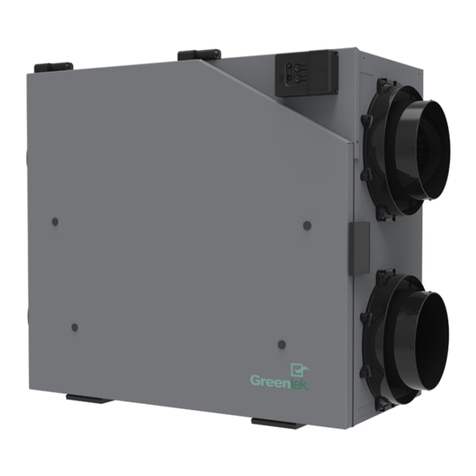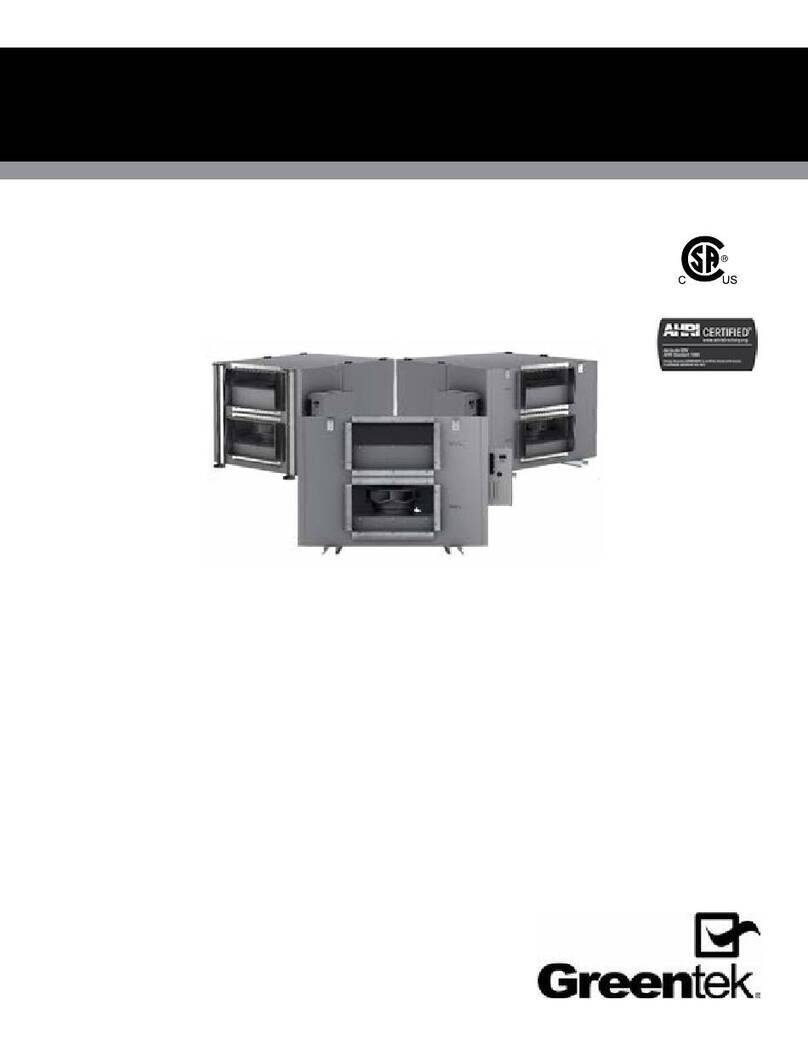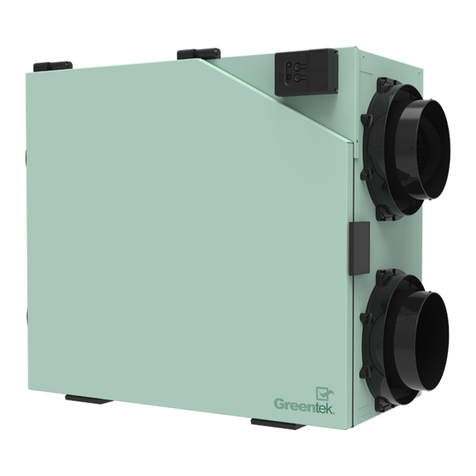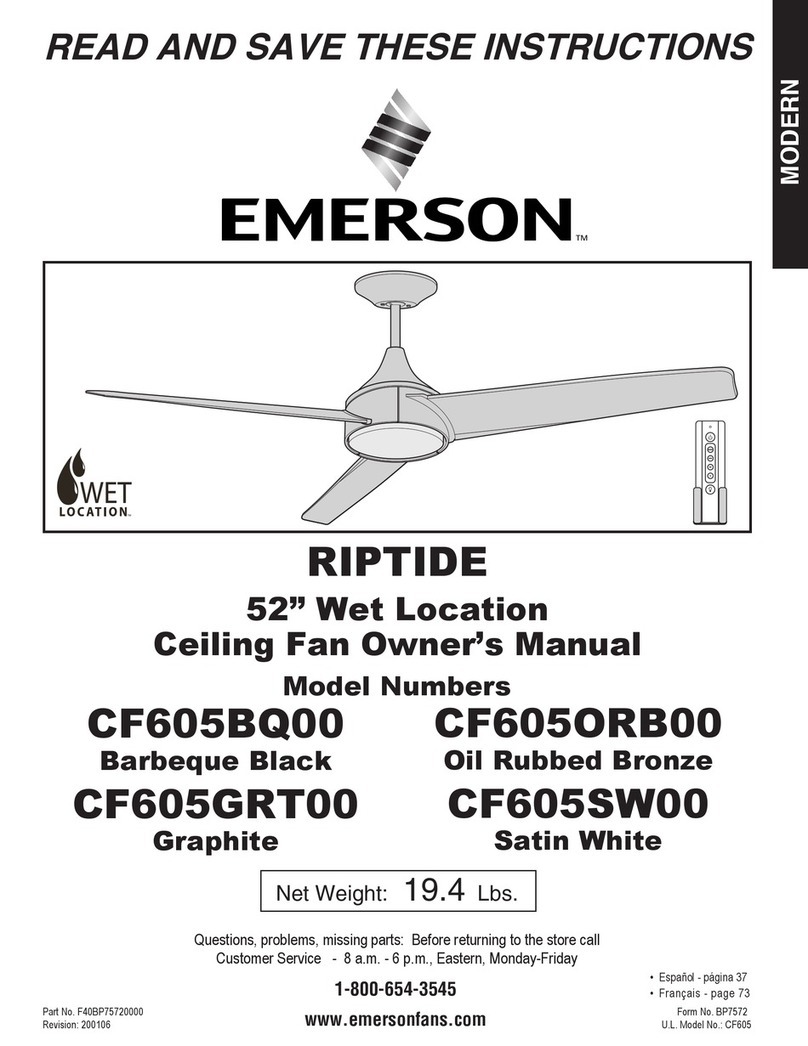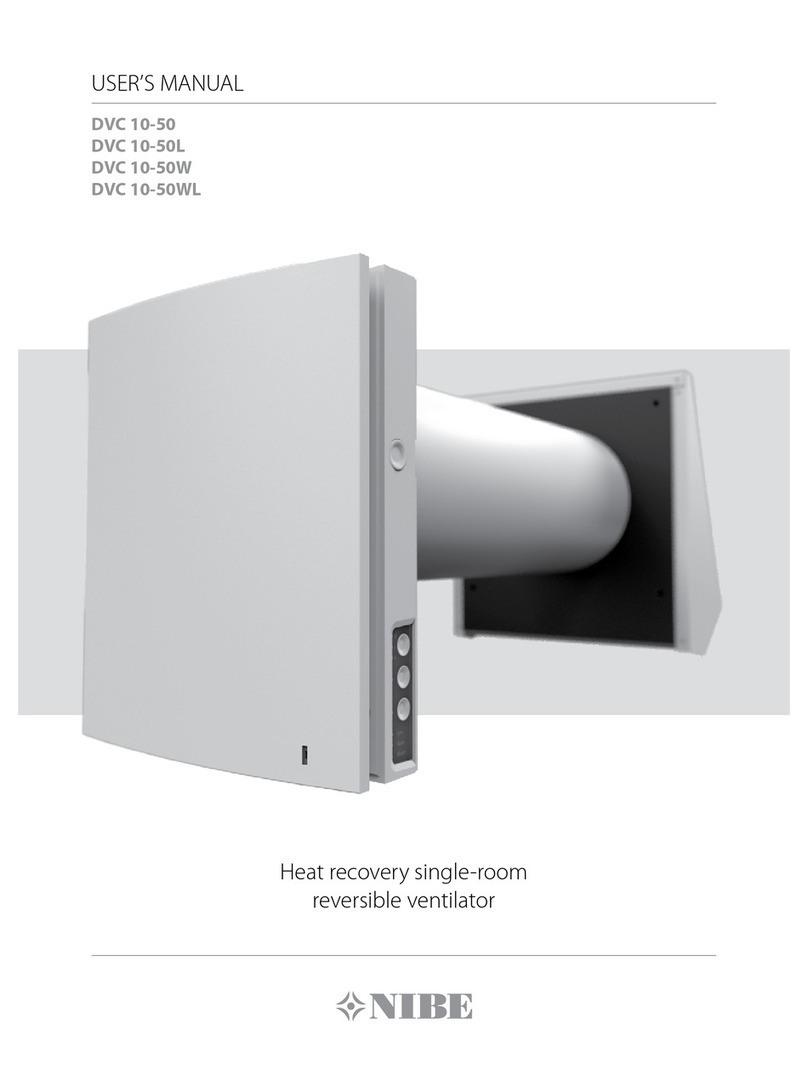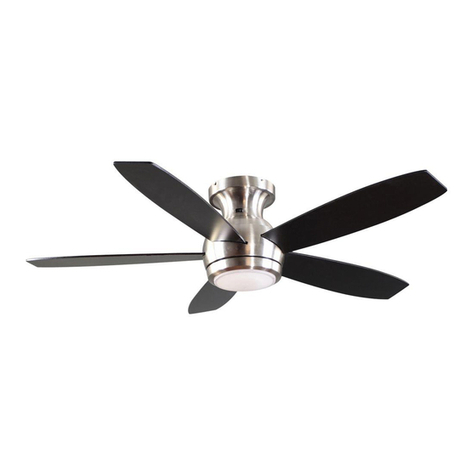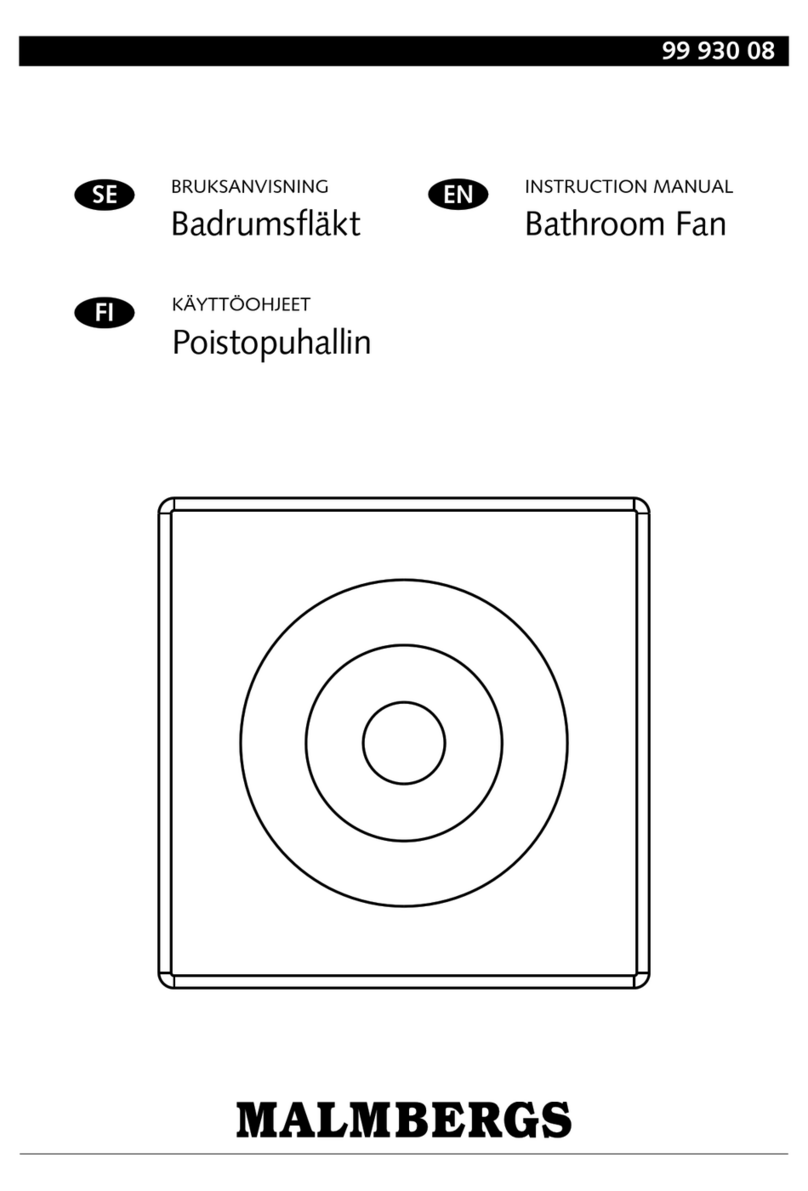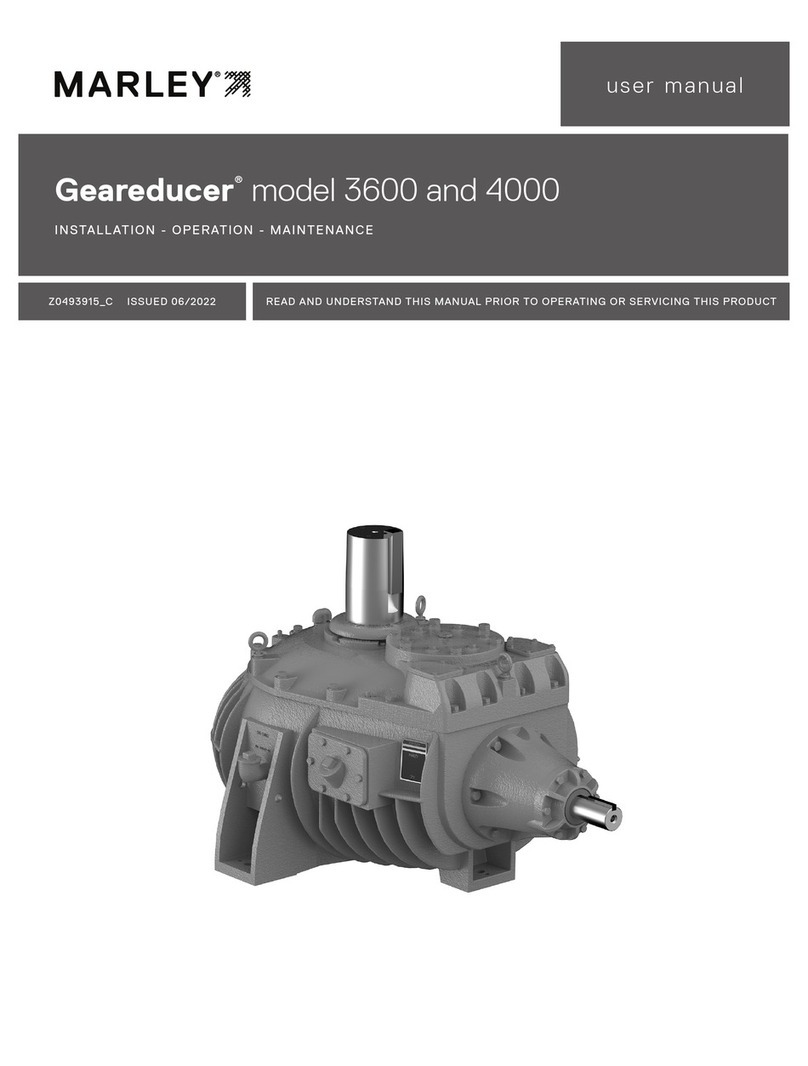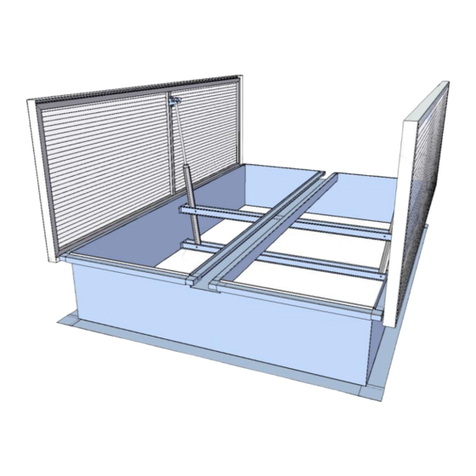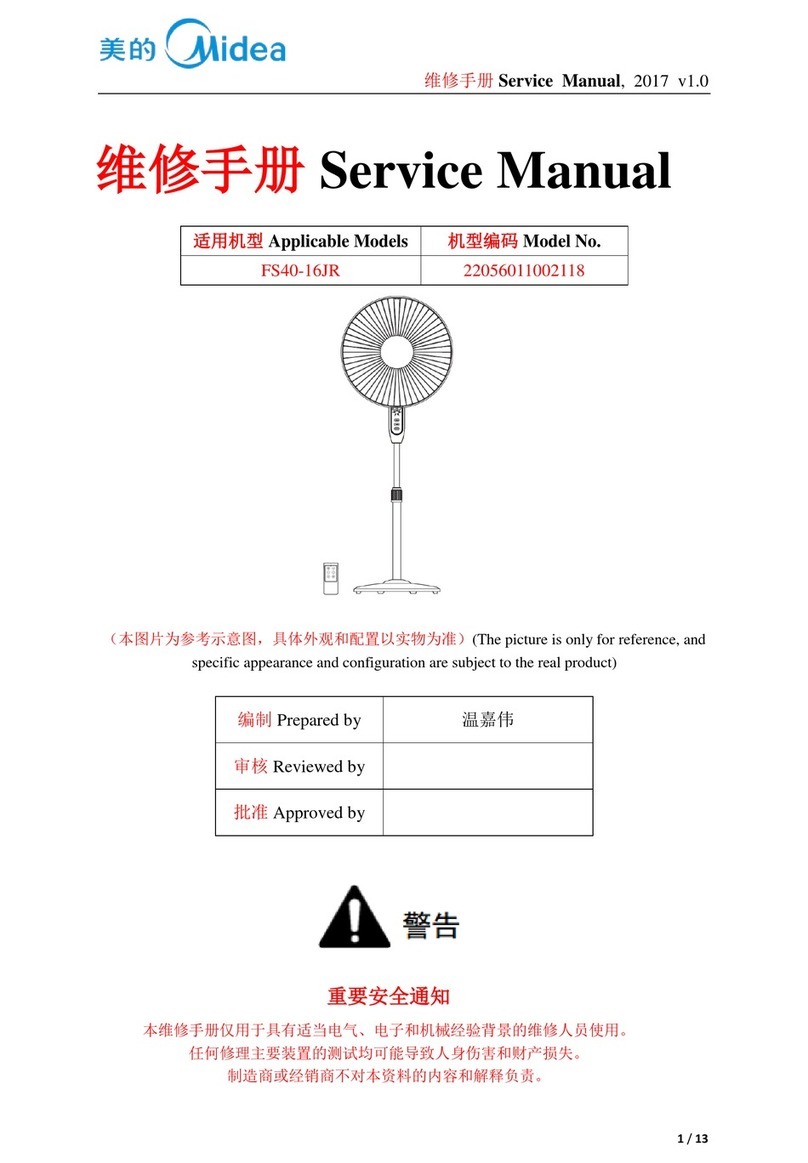Greentek LCH-4H User manual

INSTALLATION GUIDE
Greentek Models LCH-4H (Item No. 463300)
LCH-7H (Item No. 463301)
LCH-12H (Item No. 463302)
Product of Greentek
Greentek reserves the rights to modify a product, without prior notice,
whether in price, design, color or codes, in order to offer at all times quality products that are highly competitive.
Greentek
50 Kanalflakt Way, Bouctouche, NB E4S 3M5
Tel 1-888-724-5211 Fax 1-866-426-7430
www.Greentek.ca
Item# 444855 OCTOBER 2019

2
IMPORTANT - PLEASE READ MANUAL BEFORE INSTALLATION
NOTICE: Prior to installing, serious consideration must be taken to insure this ventilation system will operate properly if integrated to any other type of
mechanical system, i.e. a forced air system, or an air handling unit. To insure proper operation & compatibilities of both system, it is required that the
airflow’s of the LCH Heat Recovery Ventilator (HRV) be balanced, by following the procedures found in this manual.
CAUTION: DO NOT INSTALL IN A COOKING AREA OR CONNECT DIRECTLY TO ANY APPLIANCES
CAUTION: TURN OFF ALL INTEGRAL DISCONNECTS BEFORE SERVICING
TO REDUCE OR AVOID THE HAZARDS OF ELECTRIC SHOCK AND FIRE: CAUTIONS CONCERNING THE OPERATION AND FULL EFFICIENCY OF THIS PRODUCT:
• While servicing of cleaning the ventilation system, always disconnect
from the main power.
• To reduce the chance or avoid the hazards of electric shock and fire, do
not perform any service to the ventilation system other than that stated
in the operating manual instructions.
• Do not use ventilation system for outdoor application.
• Do not pull or twist electrical connection when disconnecting it from
the ventilation system.
• Do not use the ventilation system for removal of flammable fumes or near
flammable gases.
• Use a dedicated power source.
• Do not obstruct or cover the air intake or air outlet of the ventilation
system.
• Do not modify, repair or disassemble this ventilation system. They are
to be performed by authorized serviced personnel only. Fire, electrical
shock and/or bodily injury may occur if not.
• To prevent injuries, do not operate the ventilation system while servicing
or maintaining. There are impeller wheels turning at a very high speed
that must fully stop rotating prior to accessing the inside of the unit.
• Always assess the operation of the ventilation system how it may
interact with vented combustion equipment (ie. Gas Furnace, Oil
Furnace, Combustion, Appliances, etc.)
LIMITED WARRANTY APPLICATIONS
All our products are backed by the best limited warranty in the industry,
for your peace of mind.
You benefit from a 15 year limited warranty on the aluminum core, a 2-year
limited warranty on our ventilation motors and a 2-year limited warranty
on all other components.
• Schools
• Locker Rooms
• Conference Rooms
• Restrooms
• Barber Shops
• Office Buildings
• Bars & Grills
• Classrooms
• Airports
• Floral Shops
• Veterinary Hospitals
• Stores
• Large Homes
• Restaurants

3
TABLE OF CONTENTS
1. Installation .................................................................................................................................................................................................................................................. 4
2. Optional Reversible Application ........................................................................................................................................................................................................... 4
3. Mounting or Hanging the HRV ................................................................................................................................................................................................................ 5
4. Outside Fresh Air and Exhaust Air Hoods ........................................................................................................................................................................................... 6
5. Installation Ducts Warm Side to the HRV............................................................................................................................................................................................ 6
6. Balancing the Unit with the Duotrol System ...................................................................................................................................................................................... 7
7. Types of Installations.............................................................................................................................................................................................................................8-9
8 . Operating of the Duotrol System......................................................................................................................................................................................................... 10
9 . Modes of Operations ............................................................................................................................................................................................................................. 11
10. Controls Connection ............................................................................................................................................................................................................................. 12
11. Maintenance........................................................................................................................................................................................................................................... 13
12. Wiring Diagram LCH-4H ...................................................................................................................................................................................................................... 14
13. Wiring Diagram LCH-7H....................................................................................................................................................................................................................... 15
14. Wiring Diagram LCH-12H..................................................................................................................................................................................................................... 16
15. Wiring Diagram GTDMK module ....................................................................................................................................................................................................... 17
16. Limited Warranty................................................................................................................................................................................................................................... 18
Greentek Product Numbers Explained
LCH-4H
L = Light
C = Commercial
H = Horizontal Configuration
4 = 450 CFM
H = Heat Recovery (HRV)
LCH-7H
L = Light
C = Commercial
H = Horizontal Configuration
4 = 750 CFM
H = Heat Recovery (HRV)
LCH-12H
L = Light
C = Commercial
H = Horizontal Configuration
4 = 1200 CFM
H = Heat Recovery (HRV)

4
LOCATION
The HRV must be located in a conditioned area where it will be possible to conveniently service the unit. The HRV would be located in the mechanical
room, above a drop ceiling or an area close to the outside wall where the weatherhoods will be mounted. Attic installations are not normally
recommended due to extreme temperatures variation, and difficulty in performing required service & maintenance. If an attic is selected, special care
should be taken in ensuring the unit will perform as intended. Unit may need to be protected with insulated shelter, built on site.
Connecting appliances to the HRV It is not recommended, including:
• clothes dryer
• kitchen exhaust hoods
• combustion venting
• central vacuum system
These appliances may cause lint, dust or grease to collect in the HRV , damaging the unit or risk of hazard.
Connecting any of these type of appliances to the HRV will void warranty
LCH-H series has dual has access doors on the front and back. Also, the main electrical control panel may be moved from front to back allowing for
ducting layout.
OUTDOOR AIR CONNECTIONS
(COLD SIDE)
OUTDOOR AIR CONNECTIONS
(COLD SIDE)
INDOOR AIR CONNECTIONS
(WARM SIDE)
INDOOR AIR CONNECTIONS
(WARM SIDE)
Default Configuration. Unit may be easily reversed in field.
1. INSTALLATION
2. OPTIONAL REVERSIBLE APPLICATION
LCH-4H, LCH-7H, LCH-12H

5
CONDENSATION DRAIN LINE
Through normal operation and including defrost sequence, the HRV may produce some condensation. The excess condensation should flow into a
nearby drain if no drain is available a condensation pump will be required. The HRV and all condensate lines must be installed in a conditioned space
where the temperature is maintained above the freezing point. A “P” trap is required in the drain line, This will prevent odors from being drawn back up
into the unit.
Drain Fitting
To Drain
(or to condensation pump)
Tape or Tie
Wrap
"T" Connector
Connecting the drain hose with recommended “P” trap
To insure a quiet operation, vibration isolators (not included) are recommended for both applications.
SADDLE
INSTALLATION
3. MOUNTING OR HANGING THE HRV
SUSPENDED
INSTALLATION

6
OUTSIDE WEATHER HOODS
The weatherhoods must have built-in screens to prevent birds and rodents from entering into the ductwork. The outside perimeter of the weatherhood must
be sealed to prevent leakage into the building. The design and size of the weatherhoods or louvers chosen by the installer must allow for adequate free area.
GOOD INSTALL PRACTICES
• Minimum distance not less than 10 ft. (3 m) apart from each other.
• Minimum 18 inches (457.2 mm) above snow line or ground level.
Outdoor intake air weather hood should be located to avoid contamination from sources such has:
• Exhaust Air openings
• Parking lots (auto exhaust)
• Combustion appliances
• Gas meters, oil fill pipes
• Garbage containers
• Attics or crawlspaces
• Under a deck or other areas of questionable air quality.
DUCTING TO AND FROM THE HRV
Galvanized sheet metal ducting with cross section, insuring all joints and seams are sealed with an approved commercial grade duct sealant of aluminum
foil tape. The outdoor air and the exhaust air duct from the weather hoods to the HRV must be fully insulated to minimize heat loss or heat gain and to avoid
potential condensation.Insulated flex duct may be used in moderation, if sized and installed properly. (Consult local or national safety & building codes.)
NOTE TO INSTALLER:
The HRV is a balanced ventilation system is designed to introduce outdoor air to the building while exhausting the same amount from the building. The
designer and installer must comply in accordance to local or national safety & building codes.
IMPORTANT: Insure the HRV runs in conjunction with the forced air system (Ref. wiring diagram for interlock connection)
To maximize airflow in the ductwork system, all ducts should be kept has straight as possible avoiding bends as possible. Insuring all joints and seams are
sealed with an approved commercial grade duct sealant of aluminum foil tape.
Tips:
Supply air ducting
In buildings without a forced air systems, fresh air is supplied to all main living areas. To maximize comfort the fresh air distribution ensure to install the
grilles or diffusers from a high wall or ceiling locations.
4. OUTSIDE FRESH AIR AND EXHAUST AIR HOODS
5. INSTALLATION DUCTS WARM SIDE TO THE HRV

7
6. BALANCING THE UNIT WITH THE DUOTROL™ SYSTEM (LCH-4H & LCH-7H ONLY)
The light indicator shows you in which mode the
DuotrolTM System is in.
GREEN LIGHT Mode Selector
YELLOW LIGHT Balancing Mode
USING THE SELECTOR SWITCH
NOTE TO INSTALLER
When on Balancing Mode, the Selector Switch
allows you to choose the motor you want to set.
Closed Duotrol Cover
1. INTER (Exhaust Motor)
2. CONT (Both Motors)
3. OFF (Supply Motor)
Step 1 Press the (+) and (–) buttons on the Duotrol™ simultaneously
until you see the yellow light. Once the indicator light turns
yellow and the unit goes to high speed you are in balancing mode.
When in balancing mode the selector switch on the Duotrol™
becomes the motor selector switch:
INTER = Exhaust Airflow Motor
CONT = Both Motors
OFF = Supply Airflow Motor
Step 2 To adjust the (fresh air), select the «OFF» position on the
Duotrol™. To adjust the airflow rates, press the (–) button to
decrease or press the (+) button to increase the airflow rates
until you reach the calculated fresh airflow requirements.
Step 3 To adjust the (stale air) select the «INTER» position on the
Duotrol™. To adjust the airflow rates, press the (–) button to
decrease or press the (+) button to increase the airflow rates
until you reach the calculated stale airflow requirements.
Step 4 Once this is completed and you have balanced the airflow rates
required for your application. Proceed to exit the balancing
mode you must press (+) and (–) buttons on the Duotrol™
simultaneously until solid green LED appears then release. The
indicator light will turn green to indicate normal operation mode.
Step 5 Mark down the balanced air flow rates information. Apply the
label to the HRV access door for future reference (e.g. date,
balance airflow rate, your name, phone number and business
address).
Step 6 Once the HRV is balanced, switch to «CONT» on the Duotrol™
By using (+) and (–) buttons you can set the continuous speed if
required.
Note : When selecting the CONT mode: The HRV will continuously exhaust
stale indoor air to the outside and will introduce fresh outdoor
air continuously on low speed except when there is a request for
ventilation by one of the remote controllers then the ventilation system
will exchange at high speed. (Recommended for maximum indoor air
quality.)
When selecting the INTER mode: The only HRV will only run on high
speed when there is a request for ventilation. At this time the unit will
run on high speed until the level of humidity is below the set point. The
T-3 timer has completed its time period or once the cycles per hour has
completed its cycle.
DuotrolTM System
NOTICE: To balance the LCH-12H it will require balancing damper in the ductwork since the Duotrol does not offer this balancing feature at the current moment.
Pitot tube
Magnahelic gauge
Pitot tube
Magnahelic gauge
Note: Insert pitot
tube minimum 18”
from unit, blower
or elbows. The
same applies when
using air flow sta-
tions.

8
* Illustration & example, port locations and airflow directions may vary, consult unit specification sheet and drawings.
It is important the duct design is sized accordingly to the application to insure the system related to the HRVs airflow and performance specifications. The
amount of air (CFM) that an HRV will deliver is directly related to the total external static pressure (E.S.P.) of the system. Static pressure is a measure of
resistance imposed on the blower by length of duct work/number of fittings used in duct work, duct heater etc.
DIRECT DUCTED SYSTEM APPLICATION
• Exhausting of stale air accumulated in the building.
• Supply air supplied to main living areas.
• HRV airflow must be balanced according to the building’s airflow requirements.
• Optional : External heating or cooling coil may be to insure maximum comfort.
HRV
SUPPLY AIR DUCT
RETURN AIR
RETURN AIR TO HRV
AIR HANDLER
SUPPLY AIR
BALANCING DAMPERS - LCH-12H ONLY
OUTDOOR AIR
EXHAUST AIR
OUTDOOR AIR
EXHAUST AIR
HRV UNIT
SUPPLY AIR
RETURN AIR SUPPLY AIR
BALANCING DAMPERS - LCH-12H ONLY
EXTENDED EXHAUST SYSTEM APPLICATION
• Exhausting of stale air accumulated in the building.
• Supply air supplied to the return air duct of the air handler.
• Insure the HRV runs in conjunction with air handler unit.
• HRV airflow must be balanced according to the building’s airflow requirements.
7. TYPES OF INSTALLATIONS

9
* Illustration & example, port locations and airflow directions may vary, consult unit specification sheet and drawings.
HRV
RETURN AIR DUCT
AIR HANDLER
SUPPLY AIR
BALANCING DAMPERS -
LCH-12H ONLY
OUTDOOR AIR
EXHAUST AIR
SUPPLY AIR DUCT
SIMPLIFIED SYSTEM INSTALLATION
• Exhausting of stale air accumulated in the building from
the return air duct of the air handler.
• Supply air supplied to the return air duct of the air
handler unit down stream of the exhaust air.
• Insure the HRV runs in conjunction with air handler unit
• HRV airflow must be balanced according to the
building’s airflow requirements
7. TYPES OF INSTALLATIONS (CONT..)

10
8. OPERATING OF THE DUOTROL™ SYSTEM
Our Duotrol
TM
System is state of
the art technology simplified for
quick and easy operation. The
Duotrol™ System serves two
purposes:
1. ACTS AS A MODE SELECTOR IN RUN MODE
(OFF, CONT & INTER)
• OFF: When the selector switch is in the OFF position the ventilation
system will not come on even if there’s a request for ventilation from
any remote controllers.
• CONT: When the selector switch is in the CONT position the
ventilation system will exhaust stale indoor air to the outside and will
introduce fresh outdoor air continuously on low speed except when
there is a request for ventilation by one of the remote controllers then
the ventilation system will exchange at high speed. (Recommended
for maximum indoor air quality.)
• INTER: When the selector switch is in the INTER position the
ventilation system will only run on high speed when there is a request
for ventilation. At this time the unit will run on high speed until the
level of humidity is below the set point. The T-3 timer has completed
its time period or once the cycles per hour has completed its cycle.
TIP:
During hot and humid days, it is recommended that you put the
system on INTERM mode. This will reduce the amount of warm and
humid fresh air coming inside the dwelling.
NOTE:
The following controls (EHC1.0, EHC1.5, RD-2, RD-3P, RD-3D, RD-
4P & RD-4D) will override any setting on the Duotrol
TM
all except when
in the OFF position.
2. ACTS AS VARIABLE SPEED SELECTOR
(LCH-4H & LCH-7H only)
•
When the (+) button is pushed this will increase the CONT speed of
both ventilation system motors from the previous settings.
•
When the (-) button is pushed this will decrease the CONT speed of
both ventilation system motors from the previous settings.
NOTE:
When the LED stops blinking the unit is at its maximum high
speed or at its maximum low speed.
IMPORTANT:
If speed setting is too high, extreme dryness can occur
in home during winter months. If speed setting is too high, extreme
humidity levels can occur during hot humid days.
IMPORTANT:
If speed setting is too low, above normal humidity, stale
and contaminated air levels can occur in dwelling.

11
1. Continous
When the selector switch is in the CONT position the ventilation system will exhaust
stale indoor air to the outside and will introduce fresh outdoor air continuously on low
speed except when there is a request for ventilation by one of the remote controllers
then the ventilation system will exchange at high speed. (Recommended for maximum
indoor air quality.)
9. MODES OF OPERATIONS
Fresh air to
dwelling
Stale air to
outside
Fresh air from
outside
Stale air from
dwelling
Stale air to
outside
Stale air from
dwelling
Recirculated
air to dwelling
Normal
2a. Evacuation
2b. Recirculation
DEFROST CYCLE TYPES:
2a. Defrost sequence type: Evacuation (Ref. Supply fan shut down)
An automatic defrost sequence is activated at an outdoor measured temperature of
-5°C (23°F) and colder.
During the electronically controlled defrost sequence, the supply motor (incoming air)
shuts down while the exhaust motor continues to run to exhaust distribute warm
ambient air through the core. This eliminates the risk of the HRV core from building up
with ice and freezes.
2b. Optional Defrost Sequence Type: Recirculation (only available with GTDMK
damper module kit)
An automatic defrost sequence is activated at an outdoor measured temperature of
-5°C (23°F) and colder.
During the During the automatic defrost sequence the motorized damper closes the
incoming air port. The exhaust motor shuts down while the supply motor increases
speed and will draw warm ambient air from the 5th port located on the GTDMK damper
module kit.
GTDMK

12
CAUTION:
Minimum wire requirements is LVT18 CSA/UL 4 strain to insure proper connection.
RD-2, RD-3P, RD-4P, RD-3D, RD-4D (4 WIRES)
Installation of a RD-Series main wall control with your HRV will improve comfort and may significantly reduce the product’s energy use.
VECTRA SERIES - MODEL EHC 1.0 & EHC 1.5 (4 WIRES)
Installation of a Vectra Series main wall control with your HRV will improve comfort and may significantly reduce the product’s energy use.
To Casing
Screw
for Ground
Jumper
JP-4*
2 Relays
LVC Version 1
B
INTERLOCK
COMN.O.N.C.
RLY1
4321
D1
SW3
TIMER
REMOTE
W
B1 GR
GBR
MASTER
PROG
J2
–
+
B
INTERLOCK
COMN.O.N.C.
RLY1
4321
D1
SW3
TIMER
REMOTE
W
B1 GR
GBR
MASTER
PROG
J2
–
+
B
INTERLOCK
COMN.O.N.C.
RLY1
4321
D1
SW3
TIMER
REMOTE
W
B1 GR
GBR
MASTER
PROG
J2
–
+
R
G
R
G
R
G
B
W
R
G
B
W
BGRBGR
B
INTERLOCK
COMN.O.N.C.
RLY1
4321
D1
SW3
TIMER
REMOTE
W
B1 GR
GBR
MASTER
PROG
J2
–
+
RLY2BGWR
Jumper
JP-4*
1 Relay
LVC Version 1
B
INTERLOCK
COMN.O.N.C.
RLY1
4321
D1
SW3
TIMER
REMOTE
W
B1 GR
GBR
MASTER
PROG
J2
–
+
BGWR
B
INTERLOCK
COMN.O.N.C.
RLY1
4321
D1
SW3
TIMER
REMOTE
W
R
B1
G
W
B1 GR
GBR
MASTER
PROG
J2
–
+
R
B1
G
W
COMNCNOB G
INTERLOCK TIMER / MINUTERIE
RB/B1 WG
CONTROL / COMMANDE
R
COMNCNOB G
INTERLOCK TIMER / MINUTERIE
RB/B1 WG
CONTROL / COMMANDE
R
COMNCNOB G
INTERLOCK TIMER / MINUTERIE
RB/B1 WG
CONTROL / COMMANDE
R
COMNCNOB G
INTERLOCK TIMER / MINUTERIE
RB/B1 WG
CONTROL / COMMANDE
R
Terminal Barrier HRV/ERV Connection
Low Voltage
HRV
Controller
Low Voltage
HRV
Controller
Low Voltage
HRV
Controller
Low Voltage
HRV
Controller
Terminal Barrier HRV/ERV Connection
Terminal Barrier HRV/ERV Connection
Terminal Barrier HRV/ERV Connection
To Casing
Screw
for Ground
Jumper
JP-4*
2 Relays
LVC Version 1
B
INTERLOCK
COMN.O.N.C.
RLY1
4321
D1
SW3
TIMER
REMOTE
W
B1 GR
GBR
MASTER
PROG
J2
–
+
B
INTERLOCK
COMN.O.N.C.
RLY1
4321
D1
SW3
TIMER
REMOTE
W
B1 GR
GBR
MASTER
PROG
J2
–
+
B
INTERLOCK
COMN.O.N.C.
RLY1
4321
D1
SW3
TIMER
REMOTE
W
B1 GR
GBR
MASTER
PROG
J2
–
+
R
G
R
G
R
G
B
W
R
G
B
W
BGRBGR
B
INTERLOCK
COMN.O.N.C.
RLY1
4321
D1
SW3
TIMER
REMOTE
W
B1 GR
GBR
MASTER
PROG
J2
–
+
RLY2BGWR
Jumper
JP-4*
1 Relay
LVC Version 1
B
INTERLOCK
COMN.O.N.C.
RLY1
4321
D1
SW3
TIMER
REMOTE
W
B1 GR
GBR
MASTER
PROG
J2
–
+
BGWR
B
INTERLOCK
COMN.O.N.C.
RLY1
4321
D1
SW3
TIMER
REMOTE
W
R
B1
G
W
B1 GR
GBR
MASTER
PROG
J2
–
+
R
B1
G
W
COMNCNOB G
INTERLOCK TIMER / MINUTERIE
RB/B1 WG
CONTROL / COMMANDE
R
COMNCNOB G
INTERLOCK TIMER / MINUTERIE
RB/B1 WG
CONTROL / COMMANDE
R
COMNCNOB G
INTERLOCK TIMER / MINUTERIE
RB/B1 WG
CONTROL / COMMANDE
R
COMNCNOB G
INTERLOCK TIMER / MINUTERIE
RB/B1 WG
CONTROL / COMMANDE
R
Terminal Barrier HRV/ERV Connection
Low Voltage
HRV
Controller
Low Voltage
HRV
Controller
Low Voltage
HRV
Controller
Low Voltage
HRV
Controller
Terminal Barrier HRV/ERV Connection
Terminal Barrier HRV/ERV Connection
Terminal Barrier HRV/ERV Connection
RD-1 (2 WIRES)
Installation of a RD-1 main wall control with your HRV will improve comfort and may significantly reduce the product’s energy use.
To Casing
Screw
for Ground
Jumper
JP-4*
2 Relays
LVC Version 1
B
INTERLOCK
COMN.O.N.C.
RLY1
4321
D1
SW3
TIMER
REMOTE
W
B1 GR
GBR
MASTER
PROG
J2
–
+
B
INTERLOCK
COMN.O.N.C.
RLY1
4321
D1
SW3
TIMER
REMOTE
W
B1 GR
GBR
MASTER
PROG
J2
–
+
B
INTERLOCK
COMN.O.N.C.
RLY1
4321
D1
SW3
TIMER
REMOTE
W
B1 GR
GBR
MASTER
PROG
J2
–
+
R
G
R
G
R
G
B
W
R
G
B
W
BGRBGR
B
INTERLOCK
COMN.O.N.C.
RLY1
4321
D1
SW3
TIMER
REMOTE
W
B1 GR
GBR
MASTER
PROG
J2
–
+
RLY2BGWR
Jumper
JP-4*
1 Relay
LVC Version 1
B
INTERLOCK
COMN.O.N.C.
RLY1
4321
D1
SW3
TIMER
REMOTE
W
B1 GR
GBR
MASTER
PROG
J2
–
+
BGWR
B
INTERLOCK
COMN.O.N.C.
RLY1
4321
D1
SW3
TIMER
REMOTE
W
R
B1
G
W
B1 GR
GBR
MASTER
PROG
J2
–
+
R
B1
G
W
COMNCNOB G
INTERLOCK TIMER / MINUTERIE
RB/B1 WG
CONTROL / COMMANDE
R
COMNCNOB G
INTERLOCK TIMER / MINUTERIE
RB/B1 WG
CONTROL / COMMANDE
R
COMNCNOB G
INTERLOCK TIMER / MINUTERIE
RB/B1 WG
CONTROL / COMMANDE
R
COMNCNOB G
INTERLOCK TIMER / MINUTERIE
RB/B1 WG
CONTROL / COMMANDE
R
Terminal Barrier HRV/ERV Connection
Low Voltage
HRV
Controller
Low Voltage
HRV
Controller
Low Voltage
HRV
Controller
Low Voltage
HRV
Controller
Terminal Barrier HRV/ERV Connection
Terminal Barrier HRV/ERV Connection
Terminal Barrier HRV/ERV Connection
T3 TIMER (3 WIRES)
To Casing
Screw
for Ground
Jumper
JP-4*
2 Relays
LVC Version 1
B
INTERLOCK
COMN.O.N.C.
RLY1
4321
D1
SW3
TIMER
REMOTE
W
B1 GR
GBR
MASTER
PROG
J2
–
+
B
INTERLOCK
COMN.O.N.C.
RLY1
4321
D1
SW3
TIMER
REMOTE
W
B1 GR
GBR
MASTER
PROG
J2
–
+
B
INTERLOCK
COMN.O.N.C.
RLY1
4321
D1
SW3
TIMER
REMOTE
W
B1 GR
GBR
MASTER
PROG
J2
–
+
R
G
R
G
R
G
B
W
R
G
B
W
BGRBGR
B
INTERLOCK
COMN.O.N.C.
RLY1
4321
D1
SW3
TIMER
REMOTE
W
B1 GR
GBR
MASTER
PROG
J2
–
+
RLY2BGWR
Jumper
JP-4*
1 Relay
LVC Version 1
B
INTERLOCK
COMN.O.N.C.
RLY1
4321
D1
SW3
TIMER
REMOTE
W
B1 GR
GBR
MASTER
PROG
J2
–
+
BGWR
B
INTERLOCK
COMN.O.N.C.
RLY1
4321
D1
SW3
TIMER
REMOTE
W
R
B1
G
W
B1 GR
GBR
MASTER
PROG
J2
–
+
R
B1
G
W
COMNCNOB G
INTERLOCK TIMER / MINUTERIE
RB/B1 WG
CONTROL / COMMANDE
R
COMNCNOB G
INTERLOCK TIMER / MINUTERIE
RB/B1 WG
CONTROL / COMMANDE
R
COMNCNOB G
INTERLOCK TIMER / MINUTERIE
RB/B1 WG
CONTROL / COMMANDE
R
COMNCNOB G
INTERLOCK TIMER / MINUTERIE
RB/B1 WG
CONTROL / COMMANDE
R
Terminal Barrier HRV/ERV Connection
Low Voltage
HRV
Controller
Low Voltage
HRV
Controller
Low Voltage
HRV
Controller
Low Voltage
HRV
Controller
Terminal Barrier HRV/ERV Connection
Terminal Barrier HRV/ERV Connection
Terminal Barrier HRV/ERV Connection
10. CONTROLS CONNECTION

13
WARNING BE SURE TO DISCONNECT THE ELECTRICAL POWER BEFORE SERVICING THE SYSTEM.
ROUTINE MAINTENANCE REQUIRED
SEVEN-STEP SCHEDULE
With routine prevention maintenance, you can avoid unnecessary
problems and ensure the effectiveness of your HRV and prolong its life. For
specific routine maintenance please contact your local HVAC contractor.
1. Clean or replace air filters. Filters, which are located within the HRV
should be cleaned every two to three months. Filters should be vacuumed
first, then washed with a mild soap and water. Most washable filters will last
several years before needing to be replaced.
2. Clean the exterior intake and exhaust vents of obstructions.Check the
outside vents regularly to ensure that the screen openings are not
obstructed by grass, bushes, leaves, snow or other debris.
3. Clean and inspect the heat-exchange core twice a year and clean it as
required (consult your owner’s manual for instructions on inspecting and
cleaning the core). A build-up of dust and dirt can restrict airflow and reduce
the efficiency of your HRV. After inspection and cleaning, make sure the
core is replaced right-side-up.
4. Clean the condensate drain and pan. Twice a year, check the condensate drain and tubing to ensure that they are open and free-flowing. The tubing can
be disconnected for cleaning. The condensate drain must have a “trap” in the tubing that traps a quantity of water – to prevent air from entering the HRV via
this tubing.
5. Service the fans. The fans on the HRV’s are designed to operate continuously without lubrication. Inspect the blower fans periodically for dirt on the blades,
and remove it by gently brushing the blades or using a vacuum cleaner.
6. Clean the grilles and inspect the ductwork. Clean the grilles when they are dusty. At least once a year, visually inspect the ductwork leading to and from
the HRV. Damaged ducts can lead to condensation problems, including wet insulation, water on the floor and, ice build-up. If the insulation itself is damaged.
7. Arrange for an annual servicing. Your HRV should undergo annual general servicing by a certified contractor and who is familiar with your HRV. If possible,
have your furnace and HRV serviced at the same time; this will result in less inconvenience and cost than two separate visits.
11. MAINTENANCE
ALUMINUM CROSS-FLOW HRV CORE

14
12. WIRING DIAGRAM LCH-4H

15
13.WIRING DIAGRAM LCH-7H

16
14. WIRING DIAGRAM LCH-12H

17
15. WIRING DIAGRAM GTDMK MODULE

18
2-YEAR LIMITED WARRANTY ON COMPONENTS - Greentek warrants the components (controls, sensor & electronics) to be free from defects in
material and workmanship. If a defect is found within the models warranty period from date of original installation of the product (whether or not
actual use begins on that date). Greentek will provide a new or re-manufactured part, at its’ discretion, to authorize replacement of defective
part,without charge for the part itself.
2-YEAR LIMITED WARRANTY ON VENTILATION MOTORS – Greentek warrants the ventilation motors against defects in material and
workmanship within the models warranty period from the date of original installation. Greentek will provide a new or re-manufactured part, at its’
discretion, to authorize replacement of defective part, without charge for the part itself.
15-YEAR LIMITED WARRANTY ON ALUMINUM HEAT RECOVERY CORE – Greentek warrants the aluminum heat recovery core against defects in
material and workmanship for a lifetime from the date of original installation. Greentek will provide a new or re-manufactured part, at its’ discretion,
to authorize replacement of defective part, without charge for the part itself.
1-YEAR LIMITED WARRANTY – Greentek warrants replacement parts that have been replaced after the standard period of the previous limited
warranty, to be free from defects in material and workmanship. If a defect is found within one year from date of original installation of replacement
part, (whether or not actual use begins on that date) Greentek will provide a new or re-manufactured part, at its’ discretion, to authorize
replacement of defective part, without charge for the part itself.
WARRANTY CONDITIONS – Warranties apply only to Greentek products installed in their original location. Installation, use, care, and maintenance
must be normal and in accordance with instructions contained in the Owner’s Manual and service information. Defective parts must be returned to
the distributor through a registered servicing dealer for credit. All work shall be performed by a certified technician.
GREENTEK WILL NOT BE RESPONSIBLE FOR – Normal maintenance, installation, including filter cleaning and/or replacement, damage or repairs
required as a consequence of faulty installation, misapplication, abuse, improper servicing,unauthorized alteration or improper operation. Damage
as a result of floods, winds, fires, lightning, accidents, corrosive environments or other conditions beyond the control of Greentek. Parts not supplied
or designated by Greentek, or damages resulting from their use.
NOTICE: None of these warranties include labor or other costs incurred for diagnosing, repairing, removing, installing, shipping, servicing or
handling of either defective parts, or replacement parts, or new units.
16. LIMITED WARRANTY

19
NOTES

50 Kanalflakt Way., Bouctouche, NB E4S 3M5
1-888-724-5211 Fax 1-866-426-7430
www.greentek.ca
Item# 444855
Other manuals for LCH-4H
1
This manual suits for next models
5
Table of contents
Other Greentek Fan manuals
Popular Fan manuals by other brands
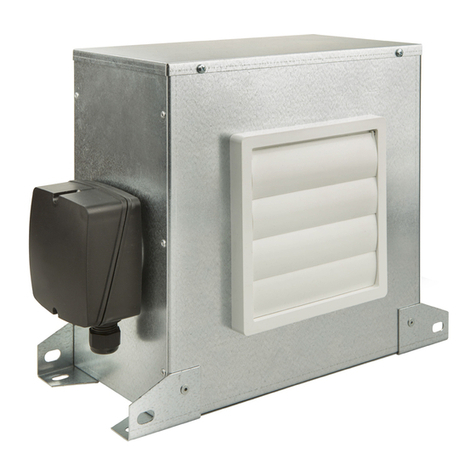
S&P
S&P CAB-E instruction manual
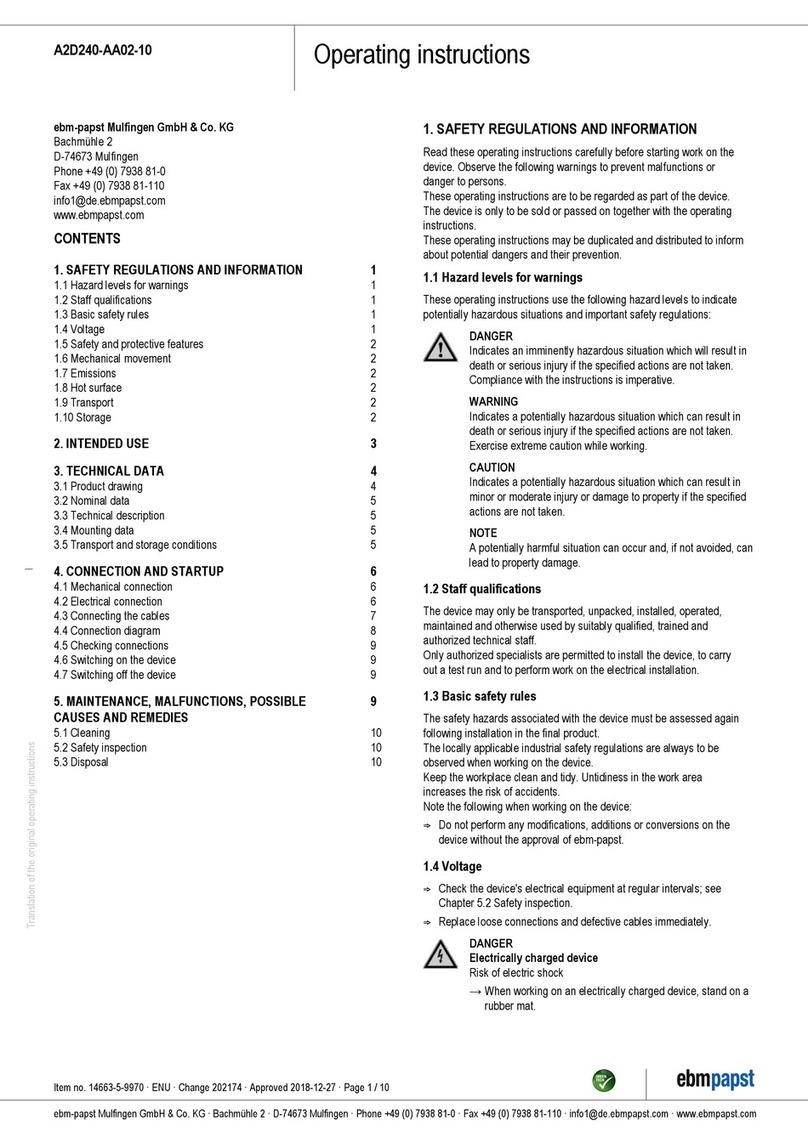
Ebmpapst
Ebmpapst A2D240-AA02-10 operating instructions
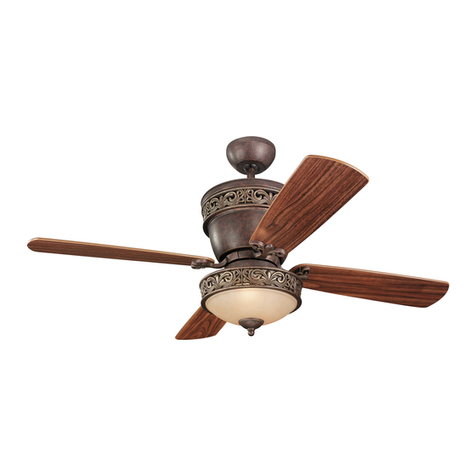
Monte Carlo Fan Company
Monte Carlo Fan Company 4vG42XXd-L series installation instructions

NOMA
NOMA Loen instruction manual
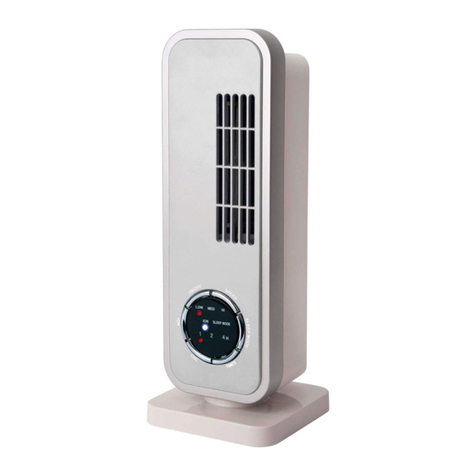
NScessity
NScessity NSMTF-18 instruction manual

Kichler Lighting
Kichler Lighting Sterling Manor instruction manual

